Topic: AIF - NZMRB - AMR
Auckland Mounted Rifles
Battle of Romani, Sinai, August 4 to 5, 1916
Auckland Mounted Rifles account about the Battle of Romani
[From: AWM ART02704]
For a contour map of the area drawn by Lambert, see:
1:40,000 map of Mt Royston area
13/112 Sergeant Charles Gordon Nicol, a member of the Auckland Mounted Rifles, a unit which was part of the New Zealand Mounted Rifles Brigade, wrote an account of this unit called The Story of Two Campains” Official war history of the Auckland Mounted Rifles Regiment, 1914 - 1919 in the Battlefields of Gallipoli, Sinai and Palestine during WWI, in which included a section specifically related to the battle of Beersheba and is extracted below. A copy of this book is available on the New Zealand Mounted Rifles Association website.
Nicol, CG, The story of two campaigns : official war history of the Auckland Mounted Rifles Regiment, 1914-1919, (Auckland 1921).
CHAPTER XVII.
Romani Opens.
Notwithstanding the fact that it was the height of summer, the Turk was about to challenge. His first concentrations, a few miles east of Katia, were observed on July 19 by General Chaytor and an airman who had taken him out for a “joy ride” after the desert had been reported clear. The force was estimated at 9,000 men with guns. The bringing of heavy guns over the desert for so many miles was a remarkable feat. It was afterwards found that in many places the Turks had made a gun road by digging ditches where the wheels were to run, and filling them with brush, which prevented the wheels sinking in the soft sand.
The Turks started to dig in on a line from Oghratina to Mageibra. All the vital eminences were held in strength, and our patrols were frequently fired on, in some cases by machine-guns. Patrols of the A.M.R., under Lieutenants Reed and Martin, were sent to Bir Nagid, some 15 to 20 miles to the south, to keep a secret watch against the enemy’s left. Secrecy demanded that this little post, so far from assistance, must be supplied with rations and water and fodder during the hours of darkness. Camels, of course, had to be used to transport the supplies, and as they took four or five hours to cover the outward journey, this was a matter of some difficulty. The fact that the camel drivers were Mohammedan Indians, under a superb looking individual who wore a sword, and that the escort was a party of A.M.R. troopers under a corporal, led to an amusing incident the first night, or rather morning. Dawn was just about to break when the loads had been taken off, and there was need for haste if the camels were to be out of sight by sunrise. The Indians did not appreciate the position, and instead of turning back at once, they washed their hands and made ready to pray as the sun came up, the individual with the sword not excepted. The A.M.R. corporal tried persuasion, but that being of no avail, he used the toe of his boot on the head Indian. This form of persuasion was quite effectual.
At the time the enemy’s intentions were not known. He was certainly expected to move forward and gain the advantages of the Katia system of oases, but there seemed every possibility that there he would wait for the British to dislodge him. The Commander-in-Chief decided to give him battle on August 13. A considerable force of infantry was in position, but the chief activity for some days was among the mounted troops of both sides. The enemy did not wait to be attacked, however. On July 27 his force, estimated now to number about 20,000 men, made an advance to Abu Darem, in the south, but was checked to some extent in the north by Light Horse and the W.M.R., with whom the latter were then brigaded.
So far the A.M.R. had remained at Hill 70 “standing by.” Important patrol duties were daily carried out. On August 1, part of the 11th squadron was sent to establish a strong post to Bir En Nuss, some miles to the east of Dudar, to sink sufficient wells to water a brigade, and part was sent to Bir Nagid to keep a watch on, the Turks. These hods were opposite the Turkish left, which was “in the blue,” the desert being its only protection, and the troopers looked forward with the liveliest anticipation to what they hoped would be a rapid out—flanking movement, the eternal dream of cavalry. The troops of Finlayson and Alsopp were in touch with enemy patrols, and were able to send in valuable information as to the activities of the enemy at Hamisah. On August 3 the remaining two squadrons relieved some Light Horse at Dueidar. That night the enemy force made a general advance, one of the fiercest fights being a delaying action by a small body of Light Horse at Hod “El Enna”. On the morning of the 4th, the Turks commenced to push forward their left flank, in a north-west direction, towards the high ground west of Bir Etmaler, and soon were on Mount Royston, a high sand dune, three miles north of Romani. This hill now became the key to the whole action. Whatever side held it would have possession of Romani, and it fell to the New Zealanders to take a prominent part in the action which regained the hill and put the seal of failure upon the hopes of the German led Turks.
At 7 a.m. the New Zealand Brigade, in which the 5th Light Horse had taken the place of the W.M.R. who had been detached for some time, got orders to move forward. The A.M.R. was at Dueidar, and got orders to join the brigade as strong as possible. The 3rd squadron and two troops of the 4th squadron rejoined the column a mile and a-half south- east of Canterbury Hill, the 11th squadron and the balance of the 4th squadron remaining to patrol the Dueidar-Katia road. About 11.30 a.m. a force of Turks, numbering 2,000, was observed on Mount Royston. About midday, after being heavily shelled by the skilful German or Austrian gunners on the ridge, a dismounted advance was ordered, the C.M.R. being on the left, the 3rd squadron of the A.M.R. in the centre, and yeomanry on the right. It was actually an enveloping movement, the New Zealanders moving against the Turkish front and the yeomanry against their southern flank. Enemy advanced posts were driven back, and the 3rd squadron, now supported by Major McCarroll with the two troops and the machine-gun section, again moved forward across the sandy “waves.” The warm fire of the Turks was returned vigor- ously by the A.M.R. machine-guns and the supporting battery, which had brought up its guns with twelve horse teams. Steadily the line moved forward, but surprisingly few casualties were suffered, one of the reasons being the advantage taken by the men of the cover offered by slight depressions, while the dangerous ruts, running parallel with the advance, were avoided. It was to be a race against time. If the hill did not fall before nightfall all the effort of the day would be lost, so a general advance was ordered for 4.45 p.m. When the moment arrived, the Turks had begun to feel the pressure of the enfilade fire from the south, and they had already evacuated a position slightly in advance of the base of the hill, and also the left end of their trenches on the ridge itself.
As soon as the final rush began the attackers were met by white flags instead of bullets. About 250 Turks were taken by the A.M.R., including a complete hospital. With the south section of the position taken, it was merely a matter of
moments before the whole position was occupied, over 1,000 prisoners being secured besides a battery of mountain guns. The first man to reach the guns was Lieutenant 0. Johnson, of the A.M.R., who was killed a few days later. In the latter stages of the action some infantry gave support on the left.
Altogether it was a very satisfactory day’s work, and the results were of the highest importance, seeing that the Turkish retirement began almost immediately. The Regiment had carried itself according to its Gallipoli traditions, and they were very tired but very satisfied men who rode back that night to rest after handing over the position to the infantry. But perhaps the proudest man of all was the padre, who had the distinction of getting a piece of metal through his hat without receiving any injury.
Additional Reading:
Battle of Romani, Sinai, August 4 to 5, 1916, Contents
Bir el Abd, Sinai, August 9, 1916
Citation: AMR, NZMRB account about Romani










